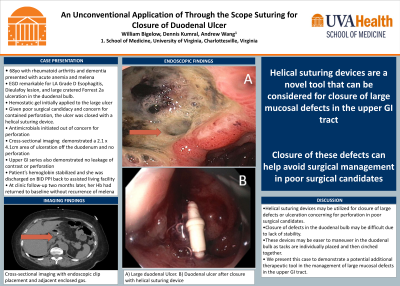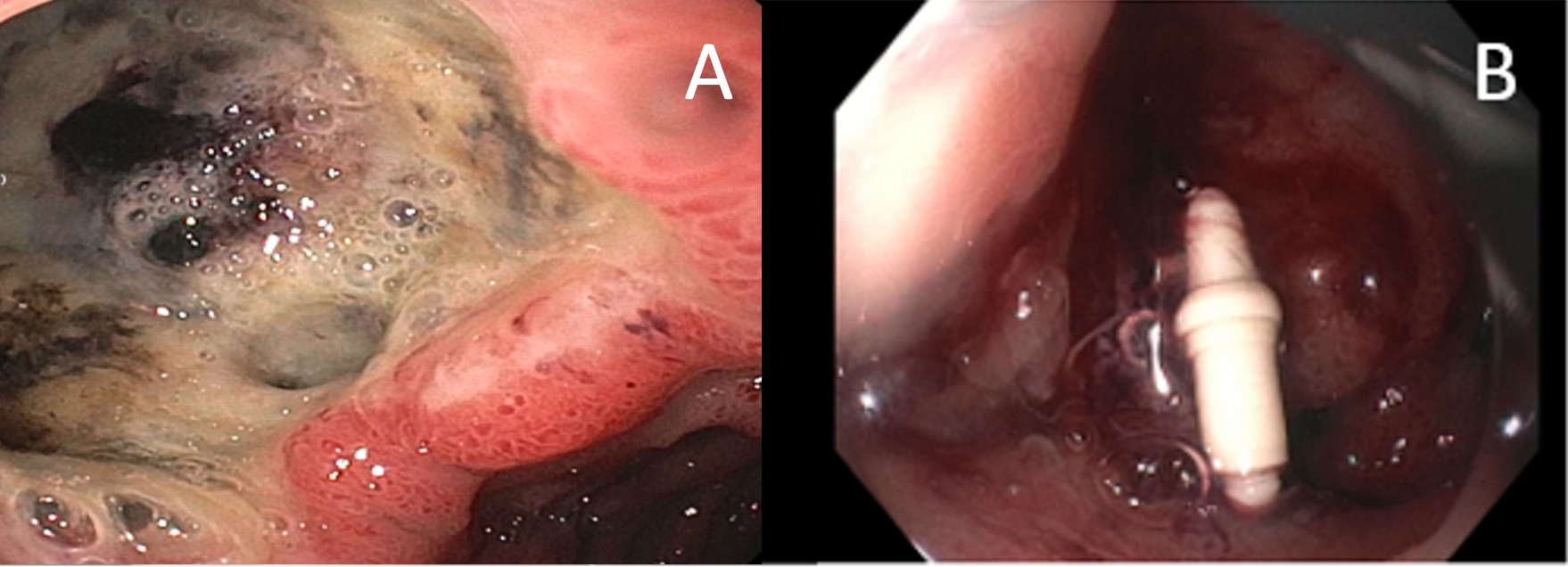Monday Poster Session
Category: General Endoscopy
P2435 - An Unconventional Application of Through the Scope Suturing for Closure of Duodenal Ulcer
Monday, October 28, 2024
10:30 AM - 4:00 PM ET
Location: Exhibit Hall E

Has Audio
- WB
William Bigelow, MD
University of Virginia
Charlottesville, VA
Presenting Author(s)
William Bigelow, MD, Dennis Kumral, MD, Andrew Wang, MD, FACG
University of Virginia, Charlottesville, VA
Introduction: Duodenal perforation from peptic ulcer disease is life-threatening with mortality rates as high as 20%. If not contained, the perforation must be closed either endoscopically or surgically. A helical suturing system is a recently developed through-the-scope device primarily designed for closure of mucosal defects from minimally invasive endoscopy procedures such as endoscopic submucosal dissection. We present a case of successful closure of a large, cratered duodenal ulcer noted on esophagogastroduodenoscopy (EGD) by a helical suturing system.
Case Description/Methods: A 68-year-old female with a history of rheumatoid arthritis and dementia presented with melena. In the setting of her rheumatoid arthritis, she had taken NSAIDs and prednisone intermittently. Her hemoglobin was 6.9 on admission down from a baseline of 11. EGD revealed LA Grade D esophagitis, multiple Forrest IIc ulcers throughout the proximal duodenum, and a large ulcer on the anterior wall of the duodenal bulb that appeared deep and concerning for perforation (Figure 1A). Initially, a mucoadhesive gel was administered to the largest ulcer site. Given the penetrating ulcer and knowledge that the patient was a poor surgical candidate, it was then closed with the helical suturing system (Figure 1B). An endoclip was used to close one remaining edge of the defect and buttress the tacks. Cross-sectional imaging post-endoscopy demonstrated a 2.1 x 4.1cm area of ulceration off the duodenum adjacent to the recently placed endoscopy clip. General surgery was consulted and recommended conservative management with nothing by mouth and antimicrobials. An upper GI series demonstrated no leakage concerning for perforation after endoscopic closure. The patient's hemoglobin stabilized, and her diet was advanced. She was discharged to her assisted living facility three days post-endoscopy.
Discussion: While we acknowledge that the helical suturing system has not been extensively studied for closure of ulcerations in the setting of a gastrointestinal bleed, it allowed us to treat a large duodenal ulceration and prevent surgery in a patient who was a poor surgical candidate due to age, dementia, and steroid use. Furthermore, the duodenum can be difficult to maintain stability for therapeutic intervention. The helical suturing device with its individually placed tacks provided increased stability. This case illustrates a potential therapeutic tool that should be further evaluated for management of large mucosal defects found on upper endoscopy.

Disclosures:
William Bigelow, MD, Dennis Kumral, MD, Andrew Wang, MD, FACG. P2435 - An Unconventional Application of Through the Scope Suturing for Closure of Duodenal Ulcer, ACG 2024 Annual Scientific Meeting Abstracts. Philadelphia, PA: American College of Gastroenterology.
University of Virginia, Charlottesville, VA
Introduction: Duodenal perforation from peptic ulcer disease is life-threatening with mortality rates as high as 20%. If not contained, the perforation must be closed either endoscopically or surgically. A helical suturing system is a recently developed through-the-scope device primarily designed for closure of mucosal defects from minimally invasive endoscopy procedures such as endoscopic submucosal dissection. We present a case of successful closure of a large, cratered duodenal ulcer noted on esophagogastroduodenoscopy (EGD) by a helical suturing system.
Case Description/Methods: A 68-year-old female with a history of rheumatoid arthritis and dementia presented with melena. In the setting of her rheumatoid arthritis, she had taken NSAIDs and prednisone intermittently. Her hemoglobin was 6.9 on admission down from a baseline of 11. EGD revealed LA Grade D esophagitis, multiple Forrest IIc ulcers throughout the proximal duodenum, and a large ulcer on the anterior wall of the duodenal bulb that appeared deep and concerning for perforation (Figure 1A). Initially, a mucoadhesive gel was administered to the largest ulcer site. Given the penetrating ulcer and knowledge that the patient was a poor surgical candidate, it was then closed with the helical suturing system (Figure 1B). An endoclip was used to close one remaining edge of the defect and buttress the tacks. Cross-sectional imaging post-endoscopy demonstrated a 2.1 x 4.1cm area of ulceration off the duodenum adjacent to the recently placed endoscopy clip. General surgery was consulted and recommended conservative management with nothing by mouth and antimicrobials. An upper GI series demonstrated no leakage concerning for perforation after endoscopic closure. The patient's hemoglobin stabilized, and her diet was advanced. She was discharged to her assisted living facility three days post-endoscopy.
Discussion: While we acknowledge that the helical suturing system has not been extensively studied for closure of ulcerations in the setting of a gastrointestinal bleed, it allowed us to treat a large duodenal ulceration and prevent surgery in a patient who was a poor surgical candidate due to age, dementia, and steroid use. Furthermore, the duodenum can be difficult to maintain stability for therapeutic intervention. The helical suturing device with its individually placed tacks provided increased stability. This case illustrates a potential therapeutic tool that should be further evaluated for management of large mucosal defects found on upper endoscopy.

Figure: Figure 1. A) Large duodenal ulcer. B) Duodenal ulcer after helical suturing system closure.
Disclosures:
William Bigelow indicated no relevant financial relationships.
Dennis Kumral indicated no relevant financial relationships.
Andrew Wang: GE HealthCare Technologies – Stock-publicly held company(excluding mutual/index funds). Pfizer – Stock-publicly held company(excluding mutual/index funds).
William Bigelow, MD, Dennis Kumral, MD, Andrew Wang, MD, FACG. P2435 - An Unconventional Application of Through the Scope Suturing for Closure of Duodenal Ulcer, ACG 2024 Annual Scientific Meeting Abstracts. Philadelphia, PA: American College of Gastroenterology.
